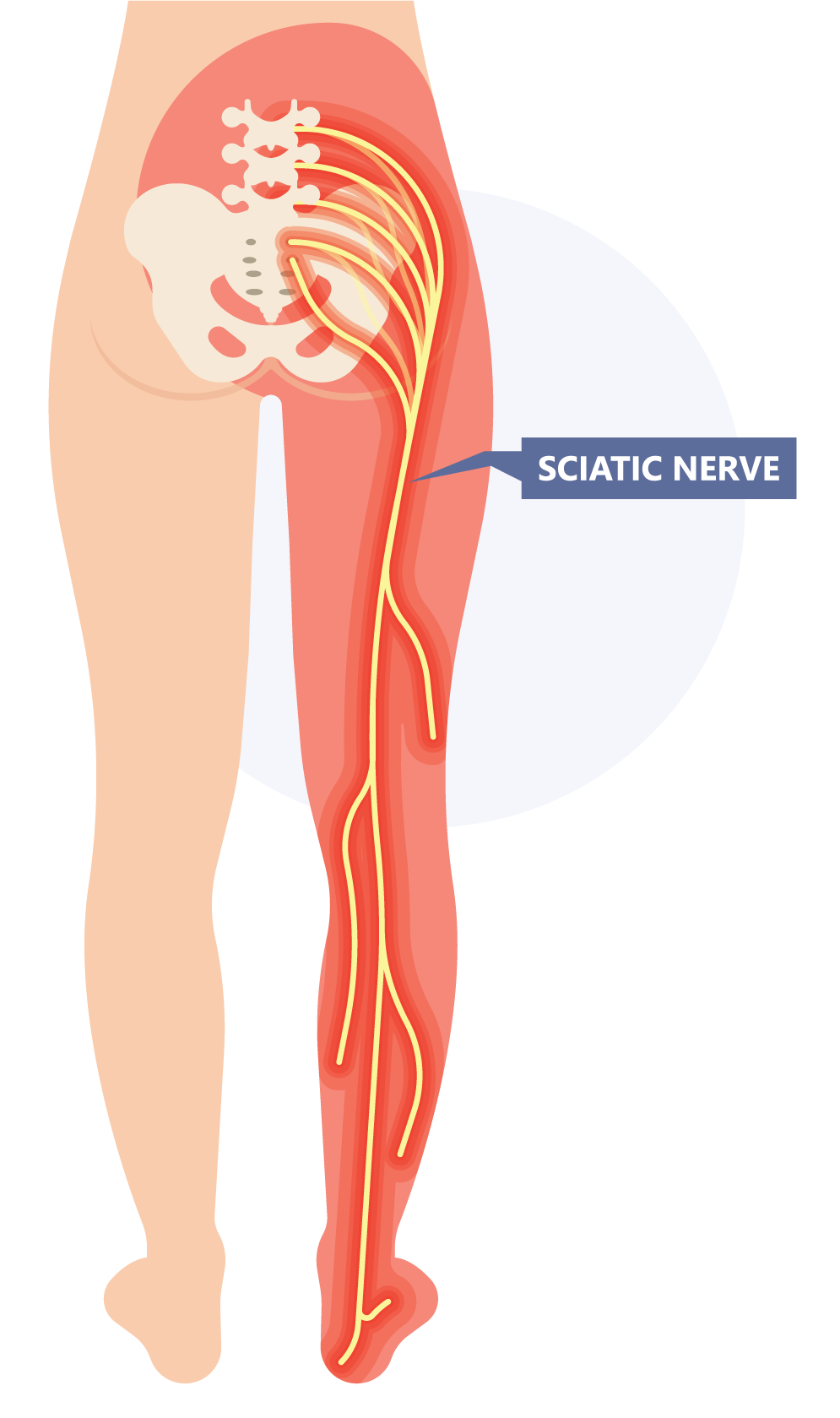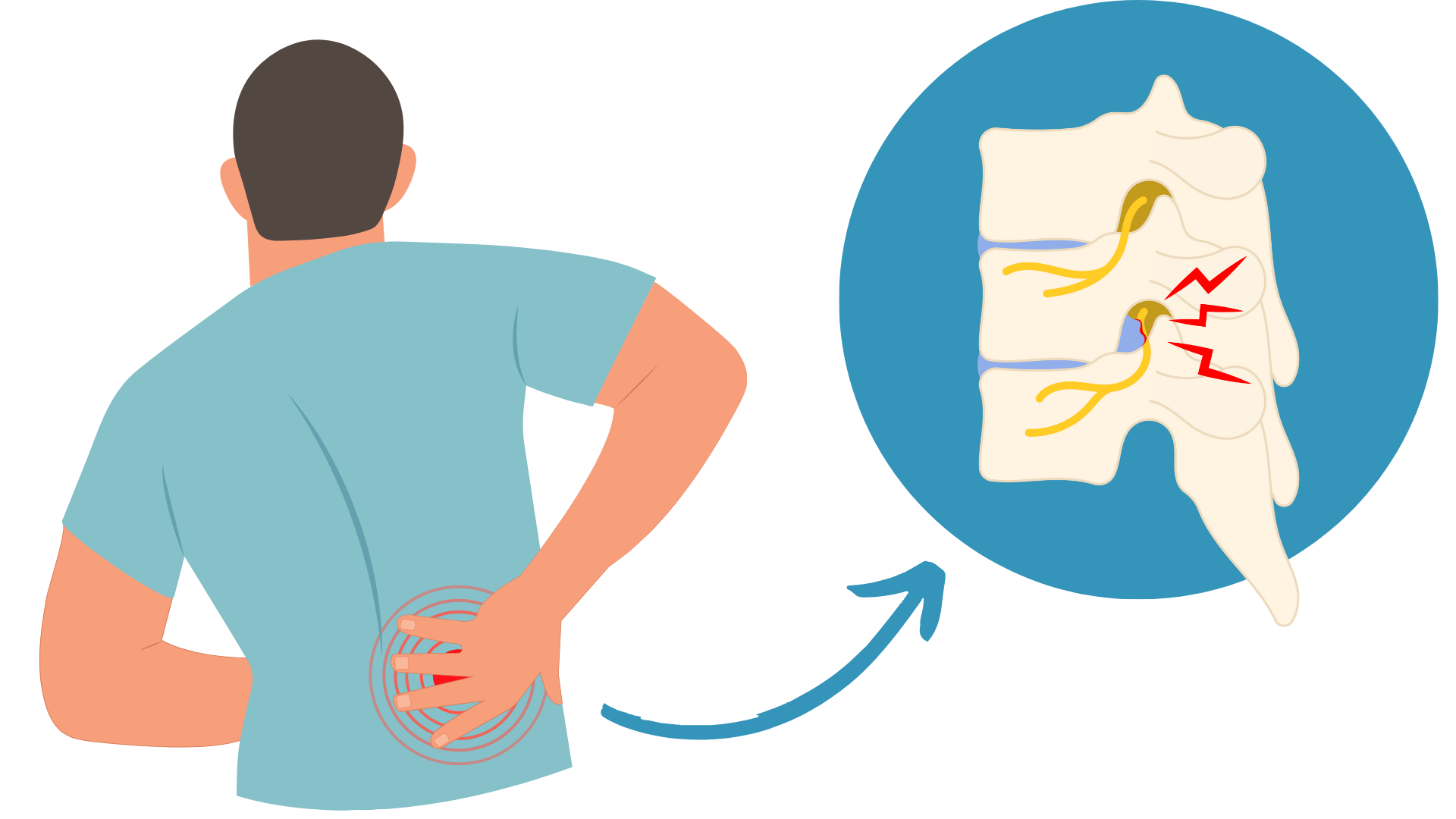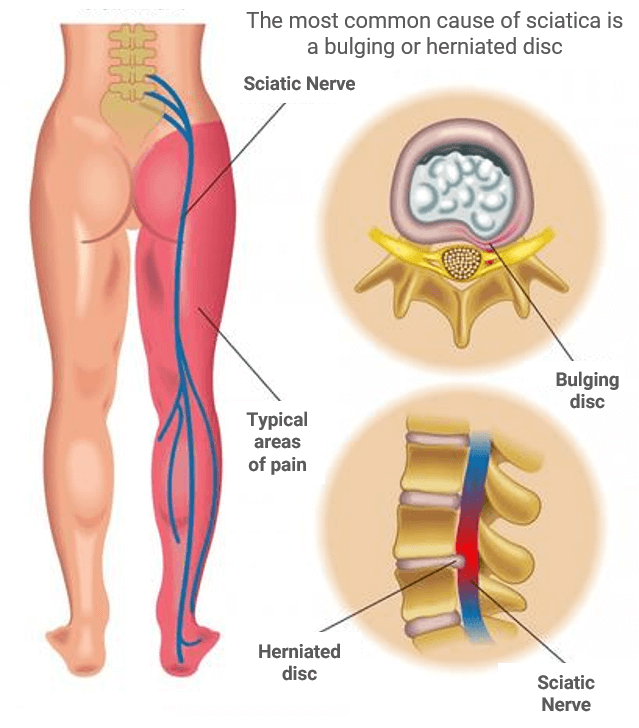
Wondering if this radiating pain down your leg is sciatica or not?
Characterized as a pain radiating from your lower back down your leg, sciatica is often the symptom of various spinal conditions such as spinal stenosis.
Hence, while exercise does alleviate the severity of the sciatica, it does not address the root cause of sciatica. People most vulnerable to sciatica often include pregnant women, heavy lifters and people leading more sedentary lifestyles.

Your sciatic nerve is your body’s longest nerve, running from your spinal cord down to each leg. Sciatica is a sensation that refers to pain, numbness, tingling, or weakness along the nerve (your hips, buttocks, legs).
Sciatica is a symptom (not a condition by itself) of pressure on the nerve that is typically caused by herniated lumbar disc, narrowing of the spine (spinal stenosis), spondylolisthesis, among others.
Pregnancy is also another common cause of sciatica.
Learn more about pregnancy pains and how to manage them here.
Most of the time, you might experience the following effects of sciatica:
Usually, only one side of your body is affected. In the event that you feel shooting pain on both sides of your body, it might be the case of bilateral sciatica.
Bilateral sciatica is very rare and may occur due to degenerative changes in the vertebrae and the disc at several spine levels, or from serious conditions such as cauda equina syndrome.
When you have a sciatica flare-up, the pain should typically radiate from your lower back down your leg. The pain can be sharp and cause you to feel pain when walking.
You might also face difficulty with sitting for long periods, and experience pain when twisting, coughing, or sneezing.
When experiencing low back pain, the pain would normally not travel below the pelvis.
Often, people confuse sciatica and diabetic neuropathy as they share very similar symptoms. Diabetic neuropathy is a type of nerve damage that occurs among diabetics. It is a serious and common complication of type 1 and type 2 diabetes.
Similarly, diabetic neuropathy causes pain in your low back, hips, or legs, and numbness and tingling sensations.
So how do I tell the difference between sciatica and diabetic neuropathy?
Thankfully, there are some key differences. Neuropathy symptoms usually start in your feet, while sciatica starts in your lower back.
Also, sciatica feels worse in the morning because of the way we sleep. When we sleep in an awkward position, this puts pressure on our nerves, causing irritations that results in shooting pains when we wake up.
Regardless of whether your shooting pain begins from your feet or from your lower back, it’s good to get checked if you feel any of these pains. Chances are, there might be some nerves that are compressed along your spinal column that’s causing you these pains.
Chiropractic care applies a quick and gentle pressure to safely and effectively adjust the spine, providing pain relief.

Meralgia paresthetica usually results in sensations of aching, burning, stabbing pains or numbness in the thigh region. It is caused from pressure on the lateral femoral cutaneous nerve (LFCN). On the other hand, sciatica is usually felt from the lower back and hips and may run down the leg.
Both pains are caused by pressure and pinching of nerves which is why they are commonly confused with each other. While they are very different conditions and have different root causes, they both can be managed and often cured through treatments.
If you are feeling pains in your lower back or leg, it is best to seek pain management as soon as possible to avoid further damage to your nerves and muscles.
Come on down for a full spinal check-up, our experienced chiropractors can help you identify what the root cause of your pain is and equip you with a care plan that works for you.
Sciatica can be acute or chronic. Unlike diseases (e.g. cancer), there are no stages to sciatica. However, if you are experiencing sharp or searing pain down your leg, are unable to flex your foot (e.g. walk on your heels), or are basically unable to walk without shedding a tear, it is time to get it checked.
Putting it off may cause serious damage or require severe intervention in the future. That is why we always believe that one should intercept such conditions early.


The most common cause of sciatica is a herniated or slipped disk that causes pressure on the nerve root. These can happen from having an active or physical lifestyle, being overweight, or simply the wear and tear of life.
Here are some common risk factors for sciatica:
Professions that require you to constantly lift heavy weights, increase the chance of developing back injuries.
Besides being a heavy lifter, having any physically strenuous job or even an active lifestyle may make you more susceptible to experiencing sciatica.
Sedentary posture can lead to joint dysfunction. This bad posture can lead to spinal misalignment, especially when repeated daily over a prolonged period of time.
Studies have shown that people who have been smoking for more than 15 years are at greater risk of suffering from sciatica. This is mainly because smoking may cause the deterioration of your spinal discs over time.
While most people believe that the extra weight bearing during pregnancy adds pressure on the sciatic nerve, that is not the main reason as to why many pregnant women experience sciatica.
In fact, it is usually due to the loosening of ligaments due to the production of hormones while pregnant, which can cause the spine to become unstable and for discs to slip.
Sciatica occurs when the spine is compressed in some way. It pinches the sciatic nerve, causing inflammation, numbness, and pain. Typically, it’s a result of a herniated disc or an overgrowth of bone, called a bone spur, on your vertebrae.
Pregnancy also causes a form of spinal compression that can affect the sciatic nerve. When you’re pregnant, the body releases a hormone called relaxin. These hormones are designed to prevent your body from having contractions that can lead to premature birth and loosen the ligaments in your pelvis.
Coupled with a growing uterus, this changes the centre of gravity and may potentially pinch the sciatic nerve, resulting in shooting pains down the legs.
Sciatic sensations are common during your pregnancy. Many pregnant women experience regular bouts of lower back pain and sciatic problems. In fact, lower back pain and sciatic problems are quite common.
Typically, sciatica is most intense in the third trimester – though it can occur at any stage of your pregnancy.
Yes, it is. Regular chiropractic adjustments realign the pelvis to create more space for the growing baby and to relieve sciatic pain & pelvic pain.
Find out more about chiropractic care during pregnancy here.

There are many self-care treatments for sciatica available online, which focus on releasing tension in the Iliopsoas or Piriformisre and aligning the pelvis through stretches and exercises.
While these may be affective in some people as they help with pressure release, the exercises may not be targetted at the correct areas for one’s unique condition. Additionally, further intervention may be required for more serious cases.
Our experienced chiropractors can help you identify the root cause of your sciatica pain and pinpoint areas that pressure needs to be released from. This way, the adjustments and recommended exercises can effectively provide pain-relief.
Mild cases of sciatica may take 4 to 6 weeks to get better. You may help to ease the pain through home treatments, such as regular exercise and use of heat packs.
However, if your pain, numbness or tingling remains for longer than that, you may need to seek professional help and start your care plan.
Our experienced chiropractors can help you identify the root cause of your sciatica pain and pinpoint areas that pressure needs to be released from. This way, the adjustments and recommended exercises can effectively provide pain-relief.
Anti-inflammatories, muscle relaxants and narcotics may be recommended to help cope with the pain.
Once the acute pain improves, a physical therapist can help with rehabilitation to prevent the worsening of your sciatica.
However, this is contingent on being physically able to proceed with stretches and exercises that may be difficult if your sciatica pain is serious.
This is usually reserved for only extreme cases of sciatica, where the pressure on the nerves cause significant pain and disfunction, such as loss of bowel and bladder control.
Surgeons can remove a portion of the herniated disc that is causing pressure on the pinched nerve.
A non-invasive and drug-free approach that focuses on spinal misalignments through a series of adjustments over a period of time.
While this method takes time, it can provide good long-term pain relief.

Sciatica typically occurs when your L4, L5, or S1 nerve roots are affected.
This could be caused by a herniated disc (also known as “slipped disc”) that compresses directly on the nerve, or degeneration of tissues in the lumbar spine. Spinal stenosis (narrowing of the spinal canal) and spondylolisthesis (a small stress fracture causing one vertebra to slip forward on another) are also potential causes.
Chiropractic adjustments target spinal misalignments that irritate the sciatic nerve, easing the pain, which allows your body to return to normal movement.
Our chiropractors here at Chiropractic Singapore are trained to diagnose the cause of sciatica and recommend how to manage your pain.
There are currently no medicinal cures for sciatica and doctors usually prescribe medication that helps with pain management, which allows you to stretch and exercise to slowly get better.
The chiropractic approach first use a series of tests to understand where the pinching of nerves are most serious.
Then, through chiropractic adjustments, provide effective pain management without the reliance on medication.
Chiropractic care therefore gives your body the nudge it needs to realign itself back to its optimal function.
A variety of exercises can help strengthen your core and improve flexibility of your lower spine. These in turn can help ease the pain of sciatica. However, it is unlikely that these will address the root cause of sciatica.
Some milder cases of sciatica can be remedied through simple at-home rehabilitation.
Here are some exercises you may perform to help ease the sciatica pain:

Lay on your back with your knees bent up and feet flat on the ground. Lift your hips up towards the ceiling.
Hold for 2 seconds before returning to the starting position. Perform 2 sets of 10 to 15 repetitions.

With a resistance band looped around just above your knees, lay on your side (affected side up) with your knees bent to about 90 degrees.
Open your top leg up towards the ceiling against the resistance and then return to the starting position. Keep your pelvis from rotating backwards as you lift. Repeat 2 sets of 10-15 repetitions.

Lay on your stomach with your elbows underneath your shoulders. Lift your body up off the floor into a plank position while keeping your hips in a straight line with your shoulders and ankles.
Keep your abdominal muscles tight and your glutes engaged. Hold for as long as you can while keeping good form.
Improving your posture can not only help relieve pain from sciatica, but can also prevent it from worsening. Therefore, it is not only important to be mindful of your lower back, but your whole spine, from your neck to your hips, to ensure good posture.
Here are some tips to make sure you have the most ergonomic set-up for your workspace and how you can keep good posture while sitting:
Adjust your office chair height so that your elbows are bent at a 90° angle while resting your forearms on the desk/armrest. This will keep the upper arms comfortably parallel to the spine.
If your chair or desk are too high but you are unable to lower them further, consider using a footstool instead of leaving them hanging all day. This will help decrease foot pain and reduce pressure on your sciatic nerve
If your chair or desk are too high but you are unable to lower them further, consider using a footstool instead of leaving them hanging all day. This will help decrease foot pain and reduce pressure on your sciatic nerve
Make sure your screen is level with your gaze when in a relaxed position. Adjust the height by using a laptop stand or get creative with a stack of books or a shoebox.
Armrests are integral in reducing neck and shoulder pain, reducing the likelihood of slouching. The armrest allows your arms to be slightly lifted at the shoulders, supporting just the elbow to take the weight off your shoulders.
While sciatica may sound scary, most cases of sciatica do not require surgery, especially when intercepted early. If your pain has been persisting for more than a few days and is not responding well to home treatment or stretches, you should come in for a check-up. It is important to address the root cause of your pain to prevent it from worsening.
At Chiropractic Singapore, our chiropractors are trained to diagnose sciatica and recommend if and how chiropractic can help. Many people overcome sciatica, all you and your body needs is time and the right care plan.
Head on over to one of our 4 clinics for a spinal check-up to start your your healing journey.
Note: The above information is not a substitute for a diagnosis or any form of medical care. Symptoms and treatments differ from person to person, and one should consult a chiropractor or a medical professional for an accurate diagnosis and recommendation.
Enjoy $55 off your first check-up (U.P. $105) using the promo code ONLINE50 at check-out.
Pssst… is it your birthday this month? Click here for an exclusive deal 
Enter your e-mail to start the booking process.
Note: X-rays and the first adjustment are not included in this promotion. For the safety of our patients, there will be no adjustments during the first visit.